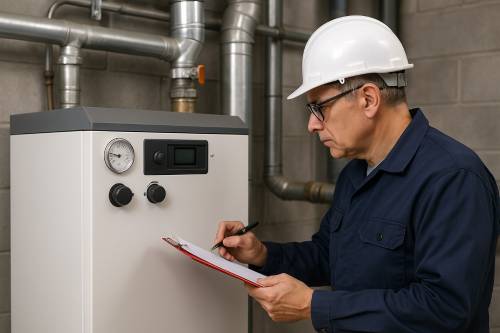What Size and Capacity Commercial Boiler Do I Need?
TL;DR: The right boiler size balances output and efficiency for your building’s real demand. London Climate Hire surveys your site (heat loss, occupancy, usage, and infrastructure) to specify a unit that runs efficiently without short-cycling or struggling at peak times.

When hiring a commercial boiler, the first question is simple but crucial: What Size and Capacity Commercial Boiler Do I Need? Oversizing burns fuel and money, while undersizing leaves the system fighting to keep up. At London Climate Hire, we match output to real-world demand through a structured site survey and clear engineering calculations.
Why Boiler Size and Capacity Matter
Capacity determines how much heat or hot water the system can deliver at any moment. In offices, hospitals, schools, hotels, or industrial sites, this directly affects comfort, safety, productivity, and running costs.
If the unit is too small, expect inconsistent temperatures, poor hot water performance, and components wearing out early. If it’s too large, short-cycling wastes energy and shortens lifespan. The result in both cases is avoidable cost and risk.
How We Determine What Size and Capacity Commercial Boiler Do I Need
Correct sizing isn’t guesswork. We assess the variables that genuinely drive demand and heat loss:
1) Building Size and Type
Larger, more complex buildings need greater output. A high-bay warehouse differs from a hotel or leisure centre. Distribution arrangements (e.g. air handling units, underfloor heating, calorifiers) also influence the required capacity.
2) Occupancy and Usage Patterns
Hotels, gyms, and care homes often see heavy, sustained hot water demand. We account for peaks (mornings, shift changes, events) to avoid performance dips.
3) Application: Space Heating, Hot Water, or Process
Some sites need process heat with tight temperature control; others prioritise space heating or domestic hot water. The application guides both type and size, and often the control strategy.
4) Heat Loss and Building Fabric
Insulation levels, glazing, air-tightness, and infiltration are key. Older or poorly insulated stock typically requires higher capacity to maintain conditions, especially in cold snaps.
5) System Efficiency and Controls
Modern condensing boilers extract more usable heat from the fuel. Weather compensation, sequencing, and quality BMS integration reduce waste and smooth operation.
Boiler Capacity Explained (kW and BTU)
Commercial boiler output is typically expressed in kilowatts (kW) or BTU/h. After calculating the site’s heat load, we select equipment that meets peak demand without unnecessary oversizing.
Very broad starting points (always refined by survey):
- Smaller commercial spaces (offices/retail): roughly 50–150 kW
- Medium facilities (schools, hotels, clinics): roughly 150–500 kW
- Large estates/industrial: 500 kW–2 MW+
Two similarly sized buildings can require very different outputs due to fabric, ventilation rates, operating hours, and hot water profiles—hence the need for a proper assessment.
What a Professional Site Survey Covers
Our surveys are practical and comprehensive. We review existing plant and distribution, available space (internal/external), access and safety, electrical supply, flue routes, controls, and the realistic heating/hot water profile across the day and week. We then specify equipment that delivers steady performance with sensible fuel consumption.
For example, a 150 kW standalone unit may suit a mid-sized office, whereas a 500 kW mobile plant room can serve a large school, leisure centre, or hotel with higher peaks.
Avoiding Common Sizing Mistakes
“Bigger is better” often backfires. Oversized plant short-cycles, wastes energy, and suffers from premature wear. Undersized plant runs flat-out, still misses set-points, and tends to need more reactive call-outs. Right-sizing protects reliability, efficiency, and whole-life cost.
Efficiency, Sustainability, and Cost Control
Correct sizing plus condensing technology and good controls can materially cut consumption and carbon. In suitable cases, hybrid approaches—e.g. a condensing boiler working alongside heat pumps or solar thermal—can reduce emissions further while retaining resilience for peak demand.
Next Steps
If you’re planning a short-term, planned shutdown, or emergency hire, explore our commercial boiler hire services for fully managed, flexible solutions tailored to your site.
For background on heat loss and design standards, see the CIBSE Guide A – Environmental Design.
FAQs
How is boiler size calculated for commercial buildings?
Engineers calculate heat load (kW) from building size, fabric, ventilation, occupancy, and usage patterns, then select plant to meet peak demand efficiently.
Can I increase capacity later if demand grows?
Yes. Modular plant and mobile plant rooms allow scalable capacity—add or remove modules seasonally or as operations change.
What happens if the boiler is the wrong size?
Undersized units struggle to meet set-points and wear quickly; oversized units short-cycle and waste fuel. Both raise operating costs and risk downtime.
Need help answering “What Size and Capacity Commercial Boiler Do I Need?” Speak to London Climate Hire for a fast survey and right-first-time specification.
